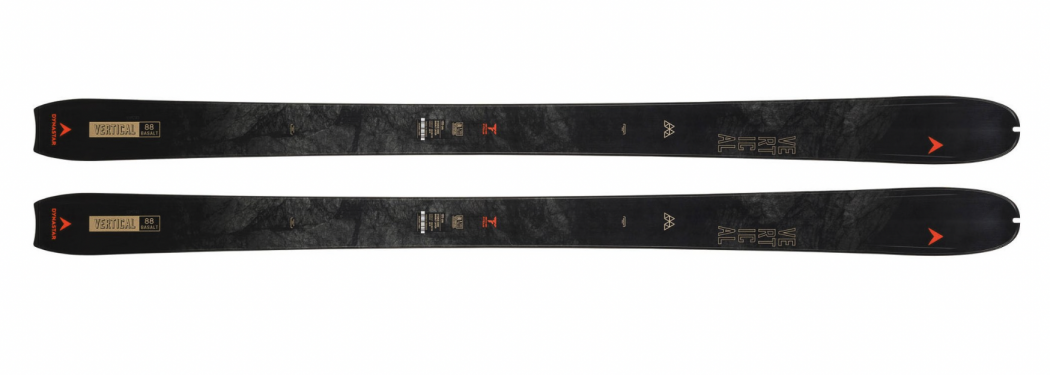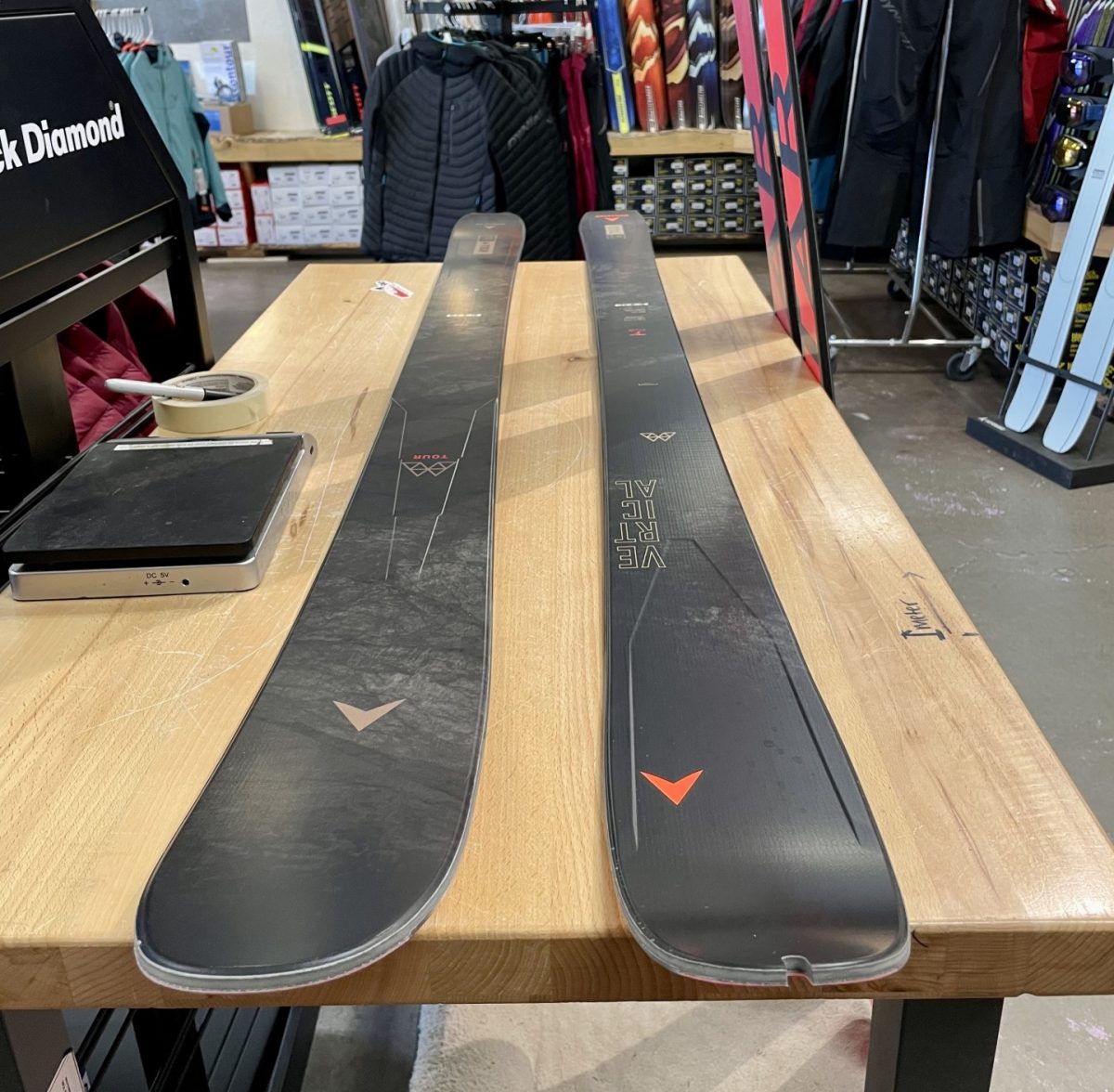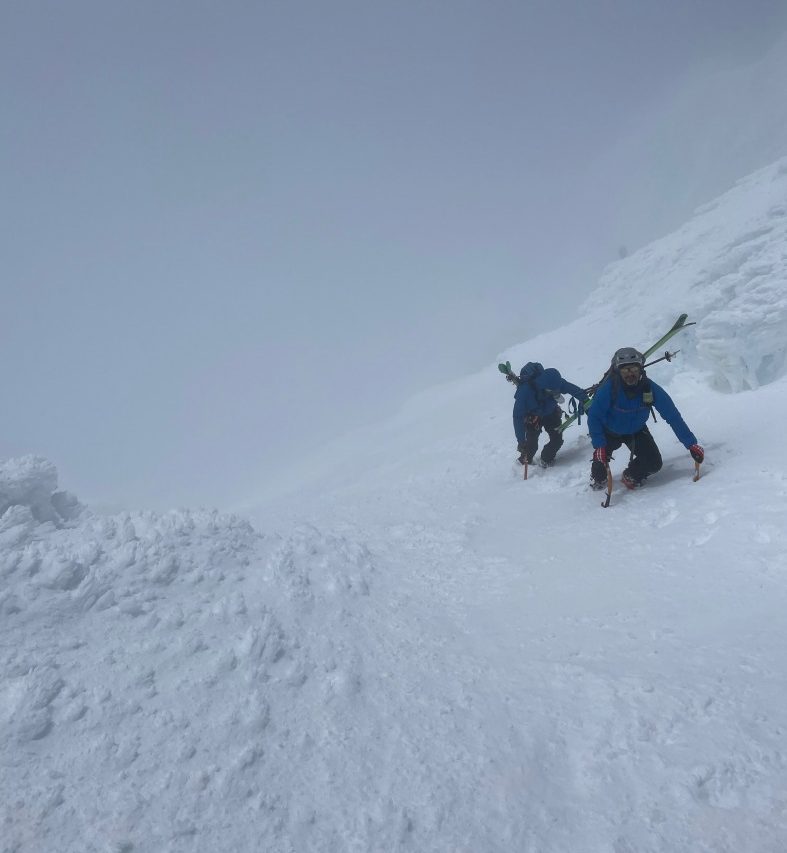
High mountain terrain trending towards steep dropping into the void: great Dynastar Vertical 88 territory. At ~1150g (172cm), it’s a ski you’ll appreciate when it’s strapped to your back or locked on your feet.
Set your sites and the scales on a svelte number, 88mm and 1150g to be precise: The Dynastar Vertical 88 delivers a lightweight ski with notable dampness. IFMGA guide Rob Coppolillo reviews the Vertical 88 and helps us discern where and when it’s best suited.
“The correct number of bikes is always n+1”
Have you seen this meme?
Or, maybe you’ve seen a sub-variant of it for … mountain boots, skis, golf clubs, you name it. Yes, your life partner thinks you’re a lunatic because you have a ski for every snow type, every type of terrain, different days of the week, and barometric pressures.
Me? No, no, of course not. I’m a mountain guide, so I actually need all the boots, skis, ropes, carabiners, etc., in my garage. Add to that my lucrative, prolific career as a writer, and, well, I think you understand now: I can justify any acquisition of any product at any time.
A set of skis specifically for no-fall terrain? Shorter, narrower boards for maneuvering in tight couloirs and “dry skiing.” But of course, my friends, I mean, I am a professional.
The Specs:
Weight:~1150g (172cm)
Construction: Sidewall Sandwich Construction (full sidewall)
Core: Hybrid Paulownia/PU core, Basalt Fiber
Dimensions (mm): 110 / 88 / 120 (172cm)
Lengths (cm): 156, 164, 172, 180
Radius (m): 20 (172cm)
Price: $699.00
For 2022/2023, Dynastar has renamed the Vertical 88 to the M-Vertical 88 F-Team, and has renamed the M-Tour 99 to the M-Tour 99 F-Team Open. Beyond the new and more verbose naming conventions and new topsheets, the skis remain identical.
The Dynastar Vertical 88
The legendary brand Dynastar makes boards in all shapes and sizes, from skinny alpine racing skis to fat-daddy freeride planks. Based in Sallanches, France, just down the hill from Chamonix, Dynastar has established itself as a blue-chip crafter of skis over its 60-year history.
Though not as ubiquitous as Atomic or Blizzard here in the States, Dynastar has of late produced some cult skis that garner rave reviews. The M-Tour 99 won Skialper’s “Ski of the Year” a couple of seasons ago, and its “Vertical” line-up is a fixture on everything from Haute Routes to opening descents throughout Europe.
The Vertical 88 gets even more hype, as French mountain guide and adventure skier, Vivien Bruchez, has been instrumental in its design. As I type this, he’s trying to get to base camp at Dhaulagiri (8167m) with at least one pair of 156cm Verticals in his quiver.
Given the popularity of the ski and its pedigree, I was curious. Over the course of the past season, I had the opportunity to ski some Vertical 88s (they also make an 82mm-waisted version) on everything from warming slush in the high Arctic to steep couloirs in the Cascades to groomed piste with the kid.

I acquired the Vertical not as a daily driver, but as a maneuverable steep-ski. I selected the 172cm (available sizes 156cm, 164cm, 172cm, and 180cm) length, and had the mad geniuses at Cripple Creek here in Seattle mount an ATK “R12” binding.
Short Ski, Burlier Binding
Dynastar doesn’t call the Vertical 88 a “steep ski,” though their collaboration with Bruchez undeniably positions it in the realm of peak bagging, couloir hunting, and ski alpinism.
Dynastar, rather, labels the Vertical “balanced,” effective for both ascent and descent. Whatever the copywriting says, the Vertical has earned a rep for being quick and capable on steep slopes and confined couloirs, if not a reliable touring ski in the tradition of lighter, narrower, “Euro” skis. After having ridden it for a season, in just about every condition except deep pow, I’d say it’s all true – it’s a versatile, lightweight ski, indeed more on the “Euro” end of the spectrum and a capable tool on steep slopes.
I acquired the Vertical not as a daily driver, but as a maneuverable steep-ski. I selected the 172cm (available sizes 156cm, 164cm, 172cm, and 180cm) length, and had the mad geniuses at Cripple Creek here in Seattle mount an ATK “R12” binding.
Unless you have an hour or two for deciphering the endless options on the ATK website, I’ll give you the punchline: the R12 binding is a slightly heavier (335g/binding vs. their “Haute Route 10” which weighs 200g/binding, for example, per the ATK website), burlier “free touring” binding (the integrated brake accounts for some of that weight). It features a wider bolt pattern in the adjustable (25mm) heel piece, which is nice because, in theory, wider bolts resist pulling out better than a fixed-position heel piece, whose bolts are closer together.
The R12’s heel piece relies not on an aluminum mounting plate, as the lighter ATK bindings (including the Black Diamond-branded “Helio” tech bindings) do, but rather an integrated 7075 aluminum and stainless-steel unit. Instead of attaching the binding to the ski via four relatively small bolts using a Torx 20 bolt, the R12 has four large screws a few centimeters apart – good for peace of mind when coaxing oneself into no-fall terrain.
In summary, I chose a shorter Vertical 88 than I might normally, for its maneuverability and weight savings, with a burlier binding. (For an all-around touring ski, I’d probably go with the 180cm length; I’m 5’11”, 170lbs.)
For comparison, the Dynastar M-Tour 99 specs:
Weight:~1250g (170cm)
Construction: Sidewall Sandwich Construction (full sidewall)
Core: Hybrid Paulownia/PU core, Basalt Fiber
Dimensions (mm): 117/99/127
Lengths (cm): 162, 170, 178, 186
Radius (m): 20 (172cm)
Price: $819.99
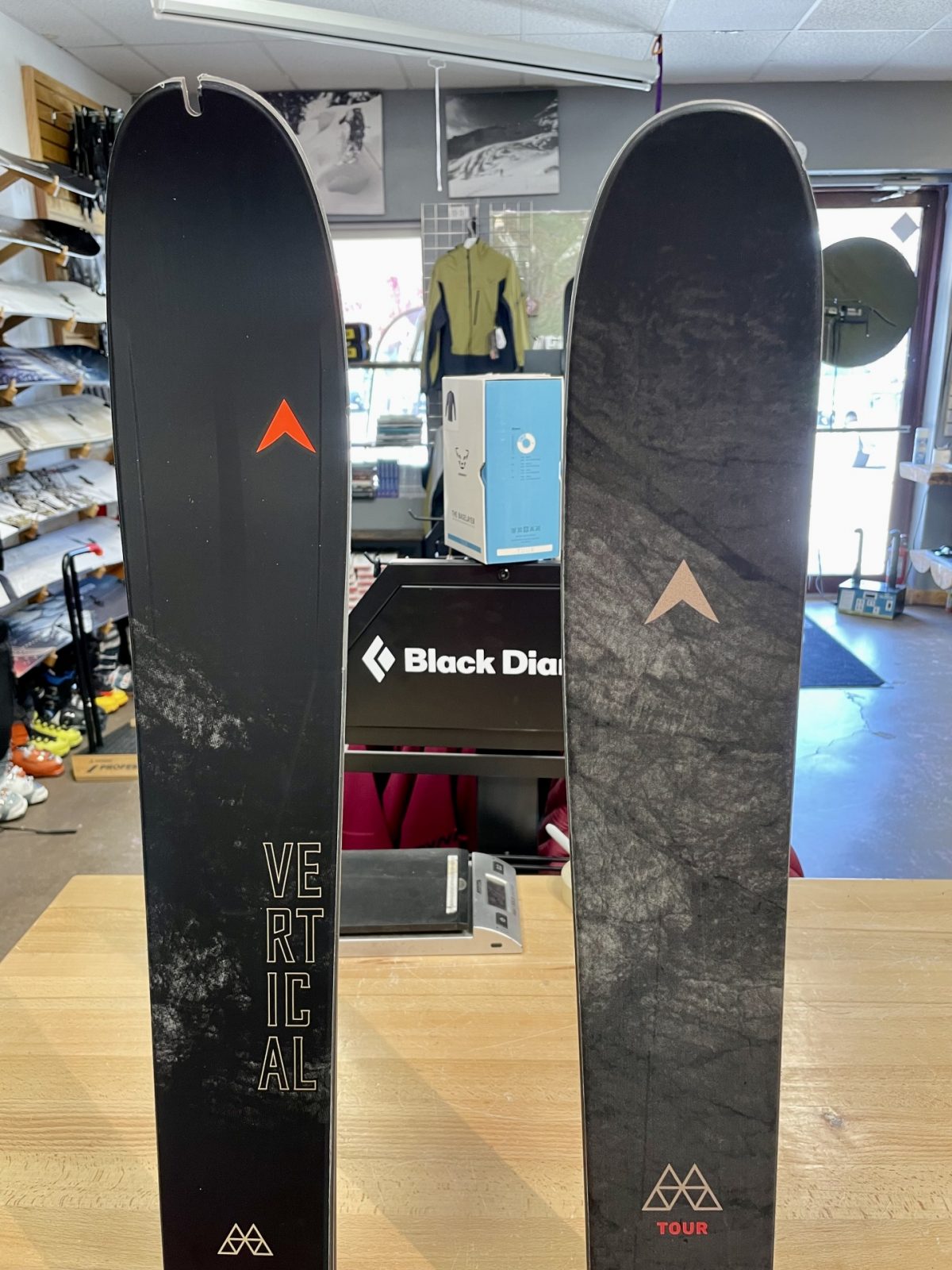
Tip comparison of the Vertical 88 (left) and the M-Tour 99 (right). The Vertical 88 sports a notched tip for those looking for speedy transitions.
The Vertical 88 Niche
I also own the Dynastar M-Tour 99 (in a 178cm), which is a marvelous quiver-of-one, with a wider shovel (dimensions: 127mm, 99mm, 117mm; 20m turn radius in the 178cm), more versatile shape, and both tip and tail “rocker” – though I’d call it more “early rise” than rockered. The M-Tour is the progeny of the immensely popular “Mythic” skis Dynastar produced over the last decade. The ski, I’d argue, makes a great daily driver in Colorado, here in the Cascades, or even Canada. Its only shortcomings might be very deep days or tighter spaces. Call it the older, more relaxed brother of the Vertical.
The Vertical 88 features a similar sidecut (120mm, 88mm, 110mm; 20m radius in the 172cm), but the ski has a flat tail and more camber. The resulting “feel” is of a straighter ski, with more edge hold, requiring more traditional technique. The Vertical’s relatively even flex and light weight (1514g/ski with the R12 binding, home verified; 1150g/ski flat per the Dynastar website) demands a centered, balanced stance while skiing it. Drive it too hard, especially with a heavier pack, and you’ll fold the tip.
The M-Tour 99 tolerates a slightly more relaxed technique and is more forgiving overall. The Vertical, especially in a shorter version, requires attention not to get sloppy.
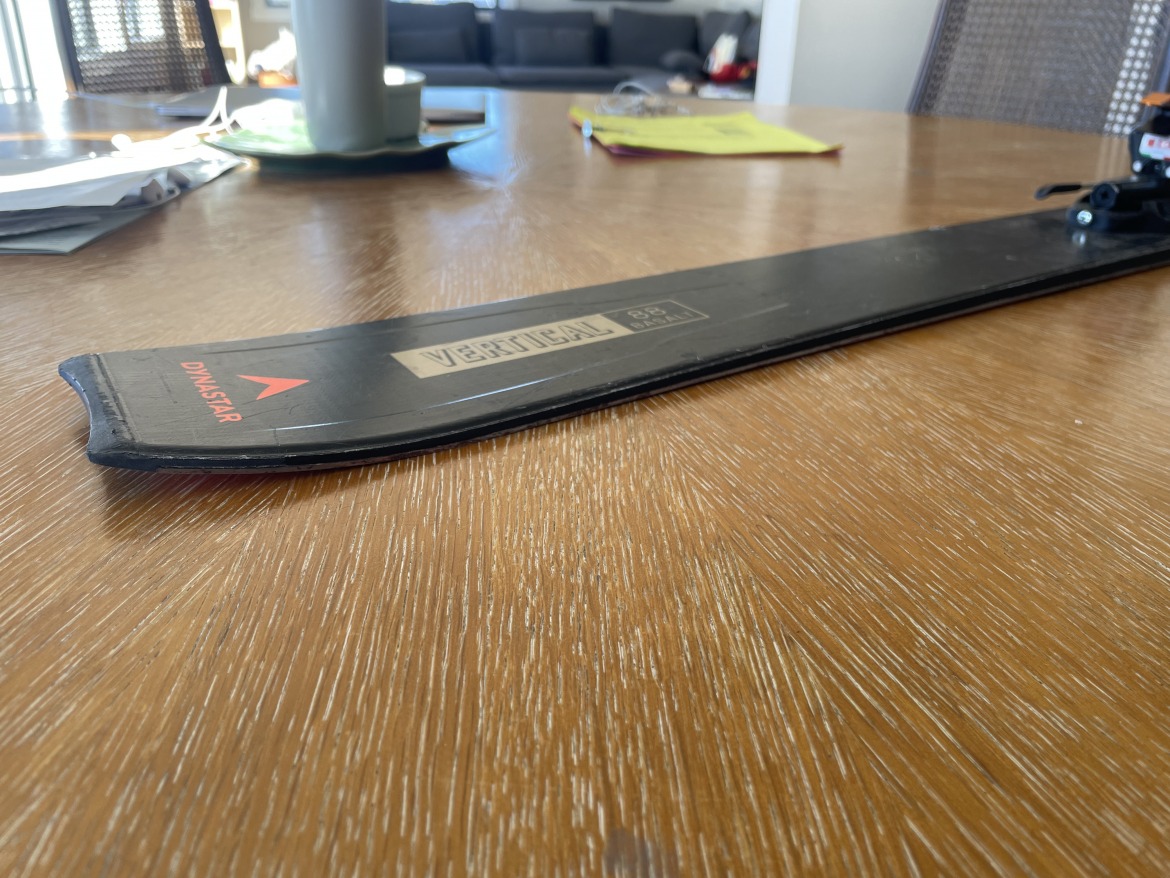
This here folks, on the Dynstar Vertical 88, is a flat tail, relatively speaking. Great for building anchors (My day job: ski guide) and for edge hold in firm/steep terrain.
Sidewalls, Construction, and Comparisons
Dynastar partners with Bruchez and the Chamonix guiding bureau, the Compagnie des Guides; this gives them plenty of expert input. The Vertical 88 feels like a ski designed by Euros. Light, with a skimo tip attachment (a cut notch in the shovel), and a flat tail, it might, at first, remind you of a Ski Trab or Movement plank.
Where the Vertical seems to get ahead, though, is in its full sidewall construction, built around a basalt-reinforced, paulownia core. You probably know paulownia, as many brands use it to lighten up their skis. Dynastar adds basalt to dampen the ride, while providing some resistance/strength. An even flex (on my subjective scale, I’d call it a 6/10) across the length of the ski, vertical sidewalls, and the core combination all make for a stable, predictable, damp ski, belying its 1150g weight.
If we’re comparing, I’d call it a tad more damp, slightly less twitchy, and a bit softer than the original Blizzard Zero G 85 and a touch more stable than the K2 Wayback 80 (which I’ve only skied for a couple of runs; grain of salt required here).
The Vertical will do just about anything you tell it to, save for deep snow and charging long-radius turns, but it requires some discipline while skiing. Stay centered, don’t overdrive it. Stick to this plan of attack, and it’s a fun ski, linking short-to-medium turns, jump-turning in couloirs, etc.
Terrain
A shorter ski makes for easy climbing on the up, no doubt. Plenty of skis fall into this 1100-ish gram category, and riding a 172cm ski makes the occasional kick-turn a relaxed affair.
Where the Vertical shines, though, is on the down. Lightweight skis often mean carbon, but the Vertical stays svelte without it. Basalt reportedly weighs 25% less than fiberglass, while offering equivalent strength. Add to this basalt’s reputed dampness, and this might be the Vertical’s selling point: reliable edge-hold, without the brittle, twitchy feel of a superlight ski. Is it the basalt? Well, who knows, but the Vertical is, above all else, predictable and reliable. Desirable traits if you’re steep skiing on them!
When considering the ski for broader use, I find myself wanting the 180cm version for more moderate terrain.
The 172cm version sure is nice, though, when side-slipping, stepping over rocks, or linking turns on steeper features. I climbed Mt. Hood with guests last spring, and we managed to ski the “Old Chute,” a fun descent that begins with a short, steep pitch (a couple sites say 50-degrees, but that seems a little optimistic) and then a consistent, open run for nearly a grand above an open, steaming crater. Don’t blow it here, people – if the fall doesn’t kill you, the gases and crater will!
I belayed the guests for the first pitch and then cautiously skied down to them – side-slipping the icy section, making a few turns, all while appreciating a predictable ski.
Outside its “home turf,” I had to ride the Vertical for a week straight on Svalbard, after a client broke his ski on day 1. I brought the Verticals as a backup, intending to ski the M-Tours. It was the first warm-up of the season in the high Arctic, so by week’s end, we were skiing boot-top slush in places. Less than ideal, but I survived on the Verticals and was surprised at its willingness to rally in manky conditions.

Part of the Vertical’s versatility comes from its strategic use and design of its early-rise tip. In variable snow (and slush, I guess), it does provide a bit of float and forgiveness – appreciated! Load the ski, though, and the early-rise disappears quickly, and you end up getting the whole edge of the ski in contact.
Part of the Vertical’s versatility comes from its strategic use and design of its early-rise tip. In variable snow (and slush, I guess), it does provide a bit of float and forgiveness – appreciated! Load the ski, though, and the early-rise disappears quickly, and you end up getting the whole edge of the ski in contact. This results in a couple of positive traits – first, the Vertical doesn’t ski “short,” meaning you feel the whole length of the edge in contact with the slope. This characteristic means you’re truly centered on the ski rather than being centered on just the cambered section, as you often find yourself on a more aggressively rockered ski. Second, full edge contact delivers more security in steeper, firmer conditions.
Evaluating skis is always a bit of a guessing game – it’d be amazing to ski a Vertical without basalt in the core, just to compare. Or what about a slightly more aggressively rockered version? Sure, this would make comparisons more valid, but nobody has the time or money for these antics, and I’m left to semi-educated theories as to why I like or dislike the subtleties of a ski.
I think the strategic early-rise and the core construction of the Vertical set it apart as a lightweight ski that punches above its weight class in tricky terrain.
Takeaway
Dynastar offers a pre-cut skin for most of its touring collection, and you can find a handful of their skis at select retailers – check the Dynastar website for a list. I love these Verticals (and the M-Tour, too!) and would appreciate a go on some of their freeride skis.
Dynastar, for example, produces another version of its 99-underfoot ski, the M Pro 99, which is the same shape and dimensions as the M-Tour 99, but has a poplar core, titanal plate under the center portion of the ski, as well as a polyurethane layer (presumably in place of the basalt in the touring skis).
The point being – my foray into the Dynastar line-up has left me wanting more, and I’m looking forward to some more adventures on the Vertical 88. Put this ski on the list if you’re looking at the Blizzard Zero G 85, the Atomic&subId2=wildsnow Backland 85, or the K2 Wayback, to name a few of the popular options in this category.
Shop for the Dynastar Vertical 88.
Shop for the Dynastar M-Tour 99.
Rob Coppolillo is a mountain guide and writer, based on Vashon Island, in Puget Sound. He’s the author of The Ski Guide Manual.

